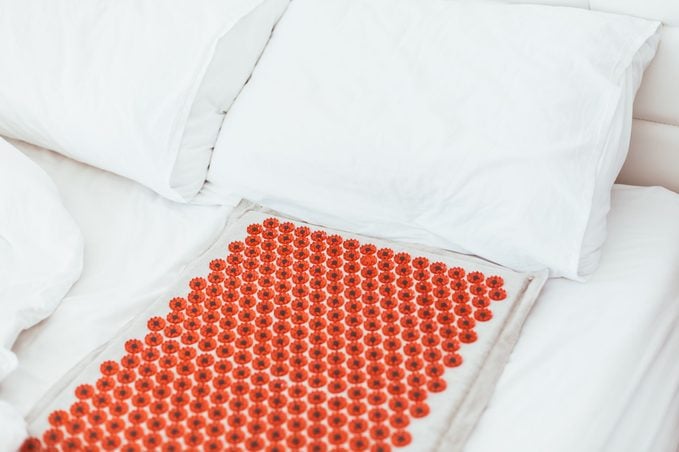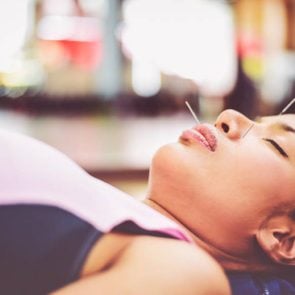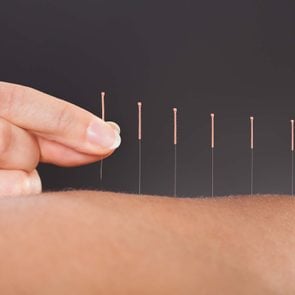Everything You Need to Know About Acupressure Mats
Updated: Feb. 19, 2021
People who struggle with issues like back pain and insomnia often turn to noninvasive alternative treatments. But should you try an acupressure mat? Here's what experts think.
Our editors and experts handpick every product we feature. We may earn a commission from your purchases.
Acupressure 101
Acupressure is the needle-free partner of acupuncture—an acupressure practitioner targets the same key points on the body but uses finger pressure instead of inserting needles. Both have roots in traditional Chinese medicine, and proponents of alternative medicine techniques claim acupressure clears blocked chi (qi), or energy in the body, which is supposed to help relieve certain conditions, such as pain or stress.
What is an acupressure mat?
Acupressure mats are sometimes called needle-stimulation pads, but that’s a bit of a misnomer. There are no needles involved, and the product isn’t intended to puncture your skin. Think of it as a yoga or workout mat with a bunch of plastic disks (each with plastic points) attached to the surface. These disks apply pressure to points on the back. There are also pillows available for use on the neck, hands, head, and feet.
Acupressure vs. an acupressure mat
Because the mats supposedly work in a similar way as acupressure and acupuncture, some proponents claim the mats offer similar benefits, such as back pain relief.
Experts do know that actual acupressure (and acupuncture) can offer relief in some situations: For example, a review of research published in JAMA Oncology in 2019 looked at the effect of acupressure and acupuncture on cancer pain relief in 31 trials (involving more than 2,000 participants). The researchers found acupressure and acupuncture helped with pain management in these cancer patients. But the research did not include acupressure mats.
That’s where things get tricky. There isn’t much research specifically on acupressure mats. Why is that important? The mats work in a different way than acupressure or acupuncture treatments.
Unlike acupressure or acupuncture, acupressure mats stimulate more than one acupressure point simultaneously. Targeted acupressure or acupuncture treatments from a professional are more individualized. (Here are the natural remedies that really work.)
“Acupressure from a licensed practitioner is more specific and tailored to the individual and the condition,” says Aileen Moy, a licensed and board-certified acupuncturist and herbalist, as well as a licensed massage therapist at the Yinova Center in New York City. “The practitioner is also able to moderate pressure and work on pressure points along the entire body and is not limited to the back, hands, feet, and neck.”
Here’s how to find your body’s acupressure points.

Acupressure mats for pain relief
The research on acupressure mats specifically is extremely limited. That said, two small pilot studies published in 2012 in the journal Evidence-Based Complementary and Alternative Medicine found that people with chronic neck and lower back pain who used an acupressure mat for daily treatments saw an improvement in their pain after two weeks.
Other potential acupressure mat benefits
Anecdotal evidence suggests these mats may reduce anxiety, promote better sleep, and provide relief from migraines. Moy also says acupressure mats help most adults with muscle stiffness or tension, pain, insomnia, and stress.
Mats are also great for general relaxation and cover a large area at one time, Moy points out. “The benefits are more frequent treatments, and it’s cost-effective,” she says. By stimulating back meridians—the energy pathways practitioners believe connect to organs in the body—you may be able to ease several issues at once, she says, such as muscle tension and poor sleep. However, there isn’t any published research on this.
The pitfalls of acupressure mats
One thing to be wary of is that the mats may create too much pressure.
Whether it’s acupressure mats, foam rollers, or balls, the goal is to release stress—”a stress transfer medium (STM),” says David Lesondak, author of Fascia: What It Is and Why It Matters and an integrative medicine expert from the Center for Integrative Medicine at the University of Pittsburgh Medical Center.
The one thing the current research is clear on is that you need some give with an STM device, according to Lesondak. “If you have something with a bit of squish to it, then you can find a happy medium and the pressure that’s appropriate for you and the pressure that’s appropriate for you in that specific part of your body,” he says. “What you might need on your calf or your hamstrings may not be what you would need on your neck or your back, and the danger or caution with a really hard STM is that you could injure yourself.”
Since acupressure mats have spikes or points across the entire mat, it is almost impossible to personalize the amount of pressure or properly target certain areas. “You’re not getting the specificity that you might need in terms of just working one segment or one area of your body,” Lesondak says.
(Here are the best products for lower back pain relief.)
Who shouldn’t use an acupressure mat?
The plastic points on an acupressure mat may pierce the skin, so they’re not advised for people with thin skin or those who are at risk from infections, such as those with diabetes or poor circulation.
Most manufacturers don’t recommend using these mats while pregnant. They’re also not approved for babies, toddlers, or small children, Moy says.
People who are bedridden or experience paralysis in the areas on which they would use the mat should also avoid using the products because they wouldn’t be able to feel whether the mat has punctured the skin or caused any other injury.
Tips for using an acupressure mat
It takes some trial and error to properly use an acupressure mat. It’s sometimes hard to overcome the initial pain or discomfort from the spikes, says Moy.
Her advice is to lay the mat on a bed, sofa, or floor and lie down slowly to distribute your weight evenly. “If you need to reposition, don’t shimmy or move while on the mat,” she says. “You can wear clothing or lay a towel over the mat until you get used to the points.”
You can also sit, stand, or place your hands on the mat. Using the mat consistently will help you adjust to the points and reap longer-lasting effects, per Moy.
(Have you heard of facial reflexology? Here’s what you need to know about this other alternative medicine treatment.)
The bottom line
Acupressure mats lack research, and they aren’t equivalent to acupuncture or targeted acupressure treatments. Limited anecdotal evidence suggests that these mats might be helpful for some people.
If you want to give acupressure mats a try, remember that they are not a replacement for professional medical care. Moy thinks it is worth buying only if you’ll use it between treatments, while Lesondak recommends purchasing softer tools instead.
















